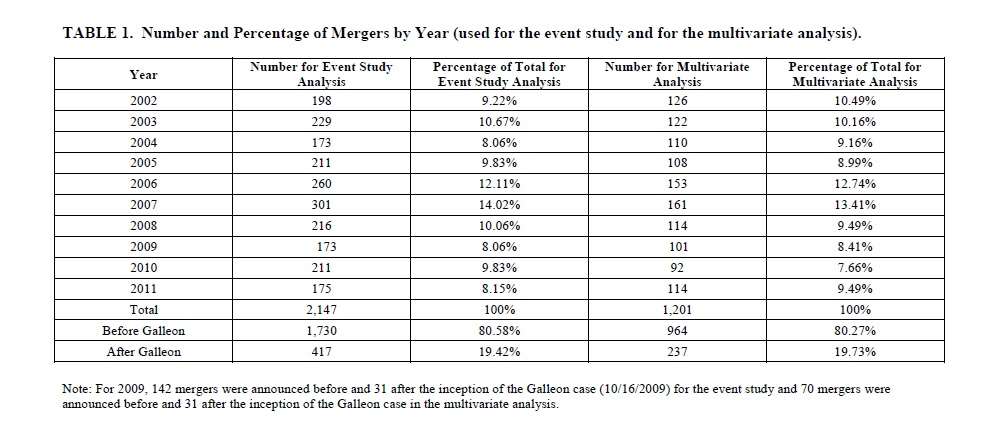 A recent study looks at the degree to which pre-merger trading activity has changed since the arrest of Raj Rajaratnam, founder of the Galleon Group.
A recent study looks at the degree to which pre-merger trading activity has changed since the arrest of Raj Rajaratnam, founder of the Galleon Group.
A Reminder
In October 2009, FBI agents arrested Rajaratnam on charges of insider trading. Others with Galleon, or with close connections thereto, were also arrested at the time or have been arrested since as the government’s investigation of the legacy of Galleon has widened. The cooperating witnesses/defendants at each stage produce a widening of the charges and targets in the next phase.
A total of 14 others had been charged in matters relating to Rajaratnam’s own arrest by November 5.
On November 24, a federal judge decided that government investigators could use wiretap recordings as evidence in the Galleon matter. That ruling kick-started the widening of this investigation. Indeed, as the authors of the new study about pre-merger trading themselves observe, until the Galleon case, ”wiretap evidence was almost exclusively used in narcotics cases.”
None of that is news to our well-informed readers of course. It does raise a fascinating question about consequences, though. Let us take it as a given that prior to that October the number of insider-trading prosecutions in the U.S. was quite limited, and that the developments since then have made it much more risky than it once was to trade in particular on the basis of a forthcoming merger announcement.
Have traders responded to that change in the manner one would expect of rational exemplars of homo economicus, rational self-interested balancers of incentives and risks?
Stock Price Runups
Two scholars at Florida Atlantic University have studied this point and replied in the affirmative. The scholars – Inga Chira and Jeff Madura – found that “the market-adjusted abnormal stock price runup of the target over days -42 to -1 relative to the merger announcement over the 84 months before the Galleon case was 5.12%” and they take this as a degree of insider or “informed” trading against an anticipated merger announcement. [Emphasis added.]
The degree of informed trading may be overstated by such a measure, because some of the eagerness to buy a target, or short an acquirer, will come not from those who actually know that an offer is in the offing but who see or surmise that the “smart money” is betting that way.
At any rate, as you can see from the above table, Chira and Madura, working from Thompson’s SDC Mergers and Acquisitions database, included in their consideration 1,730 merger announcements made before the Galleon arrests began, and 417 merger announcements thereafter. These were targets that were traded on one of three public exchanges, Nasdaq, the NYSE, or the American Stock Exchange, between July 1, 2002 and December 31, 2011.
Smaller Runups
The Wall Street Reform and Consumer Protection Act (also known as Dodd-Frank) passed the two houses of Congress and received President Obama’s signature during the period of the expanding Galleon investigation. In the view of Chira and Madura this strengthened the message that the prosecutorial activity was sending.
At any rate, their numbers indicate that the market-adjusted abnormal stock price runup of the target over days -42 to -1 in the period since the initiation of the Galleon cases has fallen to just 2.84%.
Put otherwise, pre-Galleon runups amounted to 14.8% of the takeover premium. The more modest post-Galleon run-ups amount to just 7.9% of that premium.
The conclusion then is that the arrests and prosecutions, along with the changed statutory framework, have “sent a clear signal to the traders, and that the traders are listening.”




